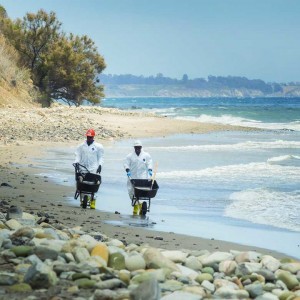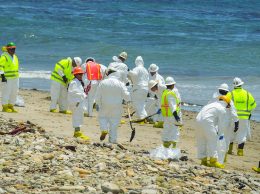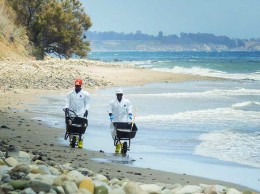No alternative to Plains pipeline monopoly
IN THIS ARTICLE
- Energy Topic
- Elijah Brumback Author
By Elijah Brumback Friday, July 10th, 2015
Despite controversy and allegations of lax oversight and maintenance of the Plains All American pipeline that ruptured and tainted the Gaviota coastline, experts say the oil pipeline is here to stay.
Like it or not, research shows that pipelines are still the safest and most environmentally friendly way to transport oil.
A 2013 report on the safety of intermodal transportation of oil by the Fraser Institute, a non-partisan Canadian think tank, concluded that pipeline oil transportation is much safer than transportation by road, rail or barge when measured by incidents, injuries and fatalities.
However, the findings are primarily based on human health and property damage, not environmental impacts, which are difficult to estimate.
A pipeline “is still the safest and best way to transport oil,” said David Hackett, president of Irvine-based Stillwater Associates, a fuels transportation consulting firm. “I’ll be very
interested to see what happens with the Plains pipeline, but the pipeline will eventually get repaired.”
Hackett has a long history in the industry and at one point was responsible for scheduling oil tankers in and out of the Ellwood oil field in the Santa Barbara Channel during the late 1970s. After a career in supply and trade with Mobil, Hackett formed Stillwater in 1997.
He said California’s pipeline network was built at a time when the state was producing more oil and has the capacity to funnel about 1 million barrels per day. Plains’ regional system alone has capacity to move about 300,000 barrels per day.
“Nobody is estimating when oil production here will go away,” Hackett said. “There have been tremendous improvements in drilling and innovations, including fracking, and those techniques are extending the life of projects.”
As an example, Denver-based Venoco believes it could extract another 60 million barrels of oil from Platform Holly, if the State Lands Board signs off on a lease amendment that would allow the company to drill existing wells deeper.
Aera Energy, an independent joint venture formed by Shell and Exxon, is also looking to redevelop a former drilling operation in the East Cat Canyon oil field in north Santa Barbara County. If approved, the company anticipates shipping crude by tanker truck to the San Joaquin Valley, where it would be transferred to existing pipelines. During the early stages of the project there could be up to about 100 truck trips a day, increasing to 190 trips, then declining over the life of the project.
“(The company) is confident that Aera’s East Cat Canyon redevelopment project application will be judged on its own merits,” the company said in a statement to the Business Times. “We believe the project will safely and responsibly produce energy while protecting the environment and providing jobs, tax revenue and community support.”
Aera is still in the early stages of the application process and is actively reaching out to neighbors and other key stakeholders, the company said.
To the north, Phillips 66 is still pursuing a project to extend the company’s rail spur at its Santa Maria facility. Additional public hearings on that effort have yet to be scheduled, but community reaction so far has been vehemently opposed to proposed plans.
When asked whether Plain’s Refugio oil spill will change the way oil is transported through the Tri-Counties, even as local legislators try to increase regulatory oversight and even bar new oil production, the answer from industry insiders is no.
However, the longer Plains’ faulty line 901 and its connection line 903 stay shut down, local producers including Venoco, Freeport-McMoran and Exxon will be more inclined to seek riskier transportation options.
“If we cannot produce for an extended period of time it will have a financial impact on the company and our community since millions in royalties to the state every year depend on production,” Michael Wracher, vice president of new ventures and exploration for Venoco, said in a statement to the Business Times. “A halt in production also will have a negative impact on the environment since production decreases the natural seeps that release oil and methane into the local environment. In the event that the pipeline is shut down for an extended period of time, we are exploring options to continue production in a safe, responsible manner.”
In late June, Exxon topped out its 400,000 gallon storage capacity at the Los Flores Canyon facility and shut down operations at three offshore platforms. But regardless of how long it takes to get the Plains pipeline back up and running, Hackett said Exxon could be making even bigger decisions regarding its future in California.
“This fallout from the spill is just one more nail in California’s coffin as far as Exxon is concerned,” he said. “The rumor mill is they are looking at selling their Torrance facility and walking away from California.”
Exxon’s possible divestiture of its Torrance facility, which spreads over 750 acres, processes an average of 155,000 barrels of crude oil per day and produces 1.8 billion gallons of gasoline per year, would leave the company with only its Los Flores Facility and Platforms. The rumored deal would also follow a string of divestitures and swaps of California assets with companies, including Valero Energy Corp. and LINN Energy.
“Chevron and Unical already made their exits and Exxon is the only major producer left,” Hackett said.
Exxon officials said they would not comment on market speculation.













